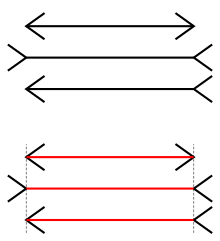Information processing paradigm
The information processing paradigm is one of the most important approaches in psychology alongside the behavioristic and psychoanalytic paradigm. It is assumed that human behavior and experience are based on information processing in the nervous system .
classification
The “ cognitive turn ” in the 1960s led psychology back to its interest in mental processes. Information processing processes and the way in which the mind processes and stores information are brought to the fore. One turns back to the internal processes that behaviorism and partly also the property paradigm have not taken into account. Characteristics and modes of experience and behavior are no longer restricted to directly observable processes. Psychoanalytic ways of thinking come to the fore again and the importance of the unconscious is clearly confirmed by the information processing paradigm. In this way, personality traits can be embedded in information processing models as stable parameters of information processing processes.
Image of man
In the information processing paradigm, humans are understood as an information processing system. There are analogies to sequential and later also to parallel processing in computers and neuroscientific models. Processing processes take place mainly unconsciously. Humans receive stimuli from the environment and their own body via the sensory organs and then convert them into other information. This information is reflected in conscious experience and behavior or motor activity and is transferred to the environment. The processes use information that outlasts the current situation; this is referred to as memory content or knowledge (declarative and procedural) . Long-term memory plays an important role in all information processing models. A distinction is made between two modes of information processing. The distinctions are partly similar, but not completely identical.
- Emotionally - rational
- Affective - cognitive
- Intuitive - analytical
- impulsive - reflexive
- Spontaneously - willingly
- Implicitly - explicitly
One example is the model by Strack and Deutsch (2004), which makes a fundamental distinction between reflective and impulsive information processing.
Personality image
Differences in the handling, reception and processing of information characterize a personality. In the information processing paradigm, personality differences are based on various aspects. The relevantesten are the architecture of the information processing , the parameters of the information processing and knowledge . The central aspect of the architecture of information processing is characterized by the fact that information processing is the same for all people, it is based on genes. There are differences in certain parameters of information processing, for example in the general speed of processing ("mental speed"), in access to short-term, long-term and working memory, in the threshold for perception, remembering and storage (experiment by Asendorpf ), in the threshold for the activation of physiological excitation and inhibition processes (Eysenck's hypothesis) and in the target values for the regulation of needs. The basis for personality differences is stable knowledge. The individual differences and peculiarities in knowledge are personality traits. The most important distinctions are the division into declarative and procedural knowledge or into explicit knowledge and tacit knowledge .
methodology
The methods of the information processing paradigm are focused on determining the parameters in the information processing processes and testing different knowledge. There are a number of different tests for recording the parameters. To test the general processing speed, one uses mental speed tests, the Sternberg paradigm (access to short-term memory ) or the NI-PI paradigm (access to long-term memory ).
In Mental Speed Tests, the information processing speed is recorded via the reaction times in differently simple and easily understandable cognitive tasks and thus different psychometric intelligence measures are predicted. The tasks consist of pairs of pictures or words, sequences of numbers or simple mathematical equations.
A well-known example of the processing speed of our brain is the Müller-Lyer illusion .
Questionnaires or interviews are used to record the explicit knowledge .
Cognitive modeling, affective or semantic priming or an implicit association test (IAT) help to capture the implicit knowledge .
The IAT is particularly interesting for personality psychology because, unlike questionnaires, it does not require explicit self-reports. Rather, the IAT is based on the measurement of reaction times, which indirectly indicate underlying personality traits.
It is claimed that explicit procedures predict controlled behavior better and implicit procedures predict uncontrolled behavior better.
Another aspect is the ability to solve complex problems. An example of this is the “mayor's game” or the Lohhausen study (Döner et al., 1983). Processes in a small town are simulated on the computer and the test subjects take on the role of mayor. The degree of problem-solving ability is determined by the result after many decisions.
Individual evidence
- ↑ http://www.psychomentalis.de/glossar/definition/?id=Informationsververarbeitungparadigma
- ↑ Myers, David G .: Psychology. 3. Edition. Springer Verlag, 2014. p. 6
- ↑ http://www.fsrpsychologie.uni-jena.de/fsr_psychologiemedia/-p-159.pdf?rewrite_engine=id
- ↑ http://lexikon.stangl.eu/1850/paradigma/
- ↑ http://www.fsrpsychologie.uni-jena.de/fsr_psychologiemedia/-p-159.pdf?rewrite_engine=id
- ↑ Bertram Gawronski: The technique of the implicit association test as a basis for objective personality tests . In: RT Proyer and KD Kubinger (eds.): In TM Ortner .
- ↑ http://www.fsrpsychologie.uni-jena.de/fsr_psychologiemedia/-p-159.pdf?rewrite_engine=id
